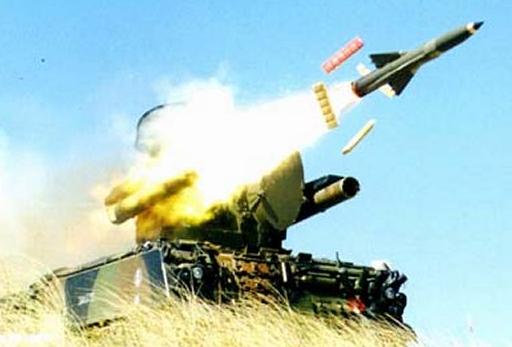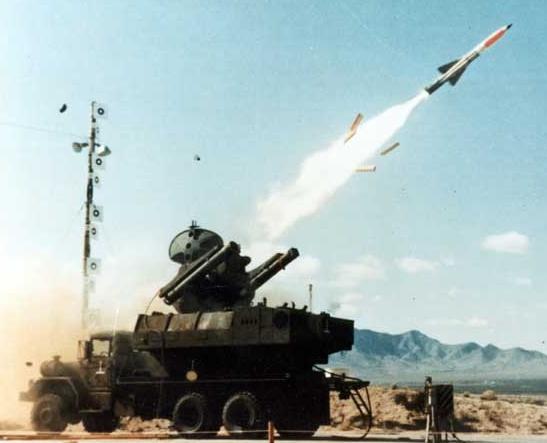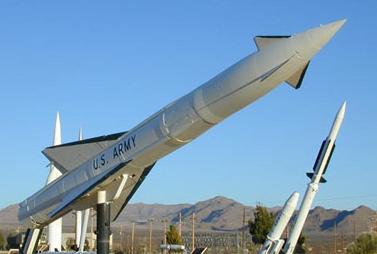Euromissile/Hughes/Boeing MIM-115 Roland
The Roland is a French/German mobile short-range surface-to-air missile system. The U.S. Army developed and evaluated an American version of the system, but in the end did not adopt it for large-scale operational service.
The development of the Roland began in 1964 as a joint project of Aérospatiale (France) and MBB (Germany), who later founded the Euromissile company for this and other missile programs. The first guided launch of a Roland prototype succeeded in June 1968. Although it had been orginally planned to field Roland by 1970, the test and evaluation phase of the system turned out to be much longer, especially for the all-weather variant. The clear-weather Roland I finally entered operational service with the French Army in 1977, while the all-weather Roland II was first fielded by the German Army in 1978.
The Roland is a very compact mobile short-range air-defense system, which combines all components on one dedicated vehicle. The missile is fired from tube-launchers and has a dual-thrust (boost/sustain) solid-fueled rocket motor. Immediately after the missile has left the tube, the four cruciform wings and small canards are extended. The wings and fins are fixed, and the Roland is steered in flight by jet vanes. A semi-automatic line-of-sight radio command guidance system directs the missile to its target, where the 6.5 kg (14.3 lb) pre-fragmented warhead is detonated by a combined proximity/impact fuze.
 |
| Photo: via FAS |
| Roland (MIM-115) |
Originally there were two basic versions of the Roland system. In both versions, incoming targets are detected by a pulse-doppler surveillance radar at a range of 16 km (10 miles), and as soon as the target is determined to be a threat, the vehicle stops and the launch turret is turned in the target's direction. In the clear-weather Roland I, an operator now finds and tracks the target in an optical sight, and fires a missile as soon as the target is within the range of 8000 m (8750 yds) (minimum range is about 500 m (550 yds)). He then has to keep the sight pointed at the target, and the Roland system, which tracks the missile's tail-mounted flares with an infrared sensor, can send appropriate radio commands to keep the missile on the line of sight until warhead detonation. In the all-weather Roland II, no operator is needed to keep target direction data up-to-date, because this information is obtained from a special tracking radar. The system then steers the missile along the tracking radar's beam until impact. The Roland system can intercept targets at altitudes between 20 m (65 ft) and 5500 m (18000 ft).
The U.S. Army's Roland program began in 1974, when the Army issued a request for proposals for a new all-weather short-range air-defense system. The Roland II was eventually selected, and in January 1975, Hughes was awarded a development contract for an American version of the system, sometimes called US Roland. The missile was to be license-built by Boeing and Hughes and was designated XMIM-115A. Adapting the system to American standards took some time, and included the development of a new target tracking radar with longer range and better jamming resistance. The Army originally mounted the US Roland system on an M109 tracked chassis, but later adopted a modified M812A1 5-ton truck as the Roland vehicle. However, the European and U.S. Roland systems were kept compatible, so that U.S. missiles could be fired from European launch units and vice versa. The first launch of a U.S.-built XMIM-115A occurred in February 1978.
 |
| Photo: U.S. Army |
| XMIM-115A |
In 1979, low-rate initial production of the XMIM-115A was approved, so that operational evaluation could begin. However, in 1981 it was decided to terminate the US Roland program and limit procurement to a single Army National Guard battalion only. American production ended in 1985 after about 600 missiles had been built. The US Roland was never declared fully operational (and therefore the missile retained its "X" prefix), and the only battalion eventually deactivated all its Roland assets in September 1988.
 |
| Photo: U.S. Army |
| XMIM-115A |
The Roland was much more successful with European and other international customers, though. In the mid-1980s, an improved Roland III system was developed, which included an uprated missile with range, speed and warhead improvements a well as improved launchers and tracking systems. Roland is still in service with several countries, and more than 25000 missile rounds have been built.
Specifications
Note: Data given by several sources show slight variations. Figures given below may therefore be inaccurate!
Data for XMIM-115A:
| Length | 2.40 m (7 ft 10.5 in) |
| Wingspan | 50 cm (20 in) |
| Diameter | 16 cm (6.3 in) |
| Weight | 67 kg (148 lb) |
| Speed | Mach 1.6 |
| Ceiling | 5500 m (18000 ft) |
| Range | 8000 m (8750 yds) |
| Propulsion | Dual-thrust solid-fueled rocket: booster: "Roubaix" rocket, 15.3 kN (3440 lb) for 1.7 s sustainer: "Lampyre" rocket, 1.96 kN (441 lb) for 13.2 s |
| Warhead | 6.5 kg (14.3 lb) pre-fragmented high-explosiveation |
Main Sources
[1] Bill Gunston: "The Illustrated Encyclopedia of Rockets and Missiles", Salamander Books Ltd, 1979
[2] Hajime Ozu: "Missile 2000 - Reference Guide to World Missile Systems", Shinkigensha, 2000
[3] Bernard Blake (ed.): "Jane's Weapon Systems 1987-88", Jane's, 1988
[4] Redstone Arsenal Historical Information Website
Back to Current Designations Of U.S. Unmanned Military Aerospace Vehicles
Back to Directory of U.S. Military Rockets and Missiles
Last Updated: 4 November 2002